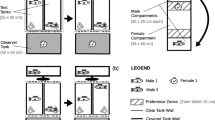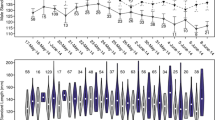Abstract
Consistent inter-individual behavioral differences in animals, or animal personalities, are increasingly recognized as an important component of sexual selection. Despite growing evidence for personality-mediated effects on reproductive success in species with biparental care, the link between personality and intrasexual competition or mate choice in species with uniparental care remains largely unexplored. Here, the non-caring sex in particular should seek partners with personality traits that promise high quality care. Therefore, we investigated effects of male personality in the common goby, a well-established model species for sexual selection under exclusive male care. Using competitive trials, we investigated how personality affects male ability to monopolize either of two central reproductive resources, nesting sites (male-male competition) and ready-to-spawn females (female choice). Personalities were scored in a feeding context and thus independent of reproduction. We found that slow-feeding individuals better succeeded in monopolizing nests, but that female spawning decisions were independent of the foraging personality of two male competitors. Instead, females showed a remarkably consistent between-female spawning preference for slightly heavier males and males with more elaborate nests. Our findings indicate that fitness benefits of the male personality type only materialize via male-male competition in environments where nesting sites are a limiting resource, whereas female choice favors large males with elaborate nests independent of male personality.
Significance statement
Animal personality can strongly affect reproductive success in species with parental care. We studied this link in the common goby, a fish where males build nests and solely take care of the brood until hatching. Hence, females should choose a male whose personality traits promise high quality care. We scored male personalities and conducted nest-competition and mate-choice trials. We found that male personality had an effect on nest monopolization, but not on female mating preferences. Instead, females agreed remarkably well in their mating decisions and consistently favored large males with elaborate nests. Our results show that male personality is important for nest allocation, which is crucial in environments where nesting sites are rare.


Similar content being viewed by others
References
Ahnesjö I, Kvarnemo C, Merilaita S (2001) Using potential reproductive rates to predict mating competition among individuals qualified to mate. Behav Ecol 12:397–401
Ahnesjö I, Forsgren E, Kvarnemo C (2008) Variation in sexual selection in fishes. In: Magnhagen C, Braithwaite VA, Forsgren E, Kapoor BG (eds) Fish behaviour. Science Publishers, Enfield, pp 303–335
Andersson M, Simmons LW (2006) Sexual selection and mate choice. Trends Ecol Evol 21:296–302
Ariyomo TO, Watt PJ (2013) Disassortative mating for boldness decreases reproductive success in the guppy. Behav Ecol 24:1320–1326
Bell AM, Hankison SJ, Laskowski KL (2009) The repeatability of behaviour: a meta-analysis. Anim Behav 77:771–783
Biro PA (2012) Do rapid assays predict repeatability in labile (behavioural) traits? Anim Behav 83:1295–1300
Borg ÅA, Forsgren E, Magnhagen C (2002) Plastic sex‐roles in the common goby—the effect of nest availability. Oikos 98:105–115
Both C, Dingemanse NJ, Drent PJ, Tinbergen JM (2005) Pairs of extreme avian personalities have highest reproductive success. J Anim Ecol 74:667–674
Brooks R, Endler JA (2001) Female guppies agree to differ: phenotypic and genetic variation in mate-choice behavior and the consequences for sexual selection. Evolution 55:1644–1655
Carter AJ, Goldizen AW, Tromp SA (2010) Agamas exhibit behavioral syndromes: bolder males bask and feed more but may suffer higher predation. Behav Ecol 21:655–661
Carter AJ, Heinsohn R, Goldizen AW, Biro PA (2012) Boldness, trappability and sampling bias in wild lizards. Anim Behav 83:1051–1058
Dingemanse NJ, Both C, Drent PJ, Tinbergen JM (2004) Fitness consequences of avian personalities in a fluctuating environment. Proc R Soc Lond B 271:847–852
Dingemanse NJ, Kazem AJ, Réale D, Wright J (2010) Behavioural reaction norms: animal personality meets individual plasticity. Trends Ecol Evol 25:81–89
Edvardsson M, Hunt J, Moore PJ, Moore AJ (2008) Female agreement over male attractiveness is not affected by cost of mating with experienced males. Behav Ecol 19:854–859
Fabre N, García-Galea E, Vinyoles D (2014) Boldness is related to the development of the cephalic crest in the male of the river blenny Salaria fluviatilis (Asso, 1801). Curr Zool 60:373–380
Forsgren E, Kvarnemo C, Lindström K (1996) Mode of sexual selection determined by resource abundance in two sand goby populations. Evolution 50:646–654
Forsgren E, Amundsen T, Borg AA, Bjelvenmark J (2004) Unusually dynamic sex roles in a fish. Nature 429:551–554
Forstmeier W, Birkhead TR (2004) Repeatability of mate choice in the zebra finch: consistency within and between females. Anim Behav 68:1017–1028
Godin J-GJ, Dugatkin LA (1995) Variability and repeatability of female mating preference in the guppy. Anim Behav 49:1427–1433
Gosling SD (2001) From mice to men: what can we learn about personality from animal research? Psychol Bull 127:45–86
Herborn KA, Heidinger BJ, Alexander L, Arnold KE (2014) Personality predicts behavioral flexibility in a fluctuating, natural environment. Behav Ecol 25:1374–1379
Heubel KU, Lindström K, Kokko H (2008) Females increase current reproductive effort when future access to males is uncertain. Biol Lett 4:224–227
Hollander FA, Van Overveld T, Tokka I, Matthysen E (2008) Personality and nest defence in the great tit (Parus major). Ethology 114:405–412
Jennions MD, Petrie M (1997) Variation in mate choice and mating preferences: a review of causes and consequences. Biol Rev 72:283–327
Johnsen TS, Zuk M (1996) Repeatability of mate choice in female red jungle fowl. Behav Ecol 7:243–246
Jones JC, Reynolds JD (1999a) Costs of egg ventilation for male common gobies breeding in conditions of low dissolved oxygen. Anim Behav 57:181–188
Jones JC, Reynolds JD (1999b) The influence of oxygen stress on female choice for male nest structure in the common goby. Anim Behav 57:189–196
Komers PE (1997) Behavioural plasticity in variable environments. Can J Zool 75:161–169
Kontiainen P, Pietiäinen H, Huttunen K, Karell P, Kolunen H, Brommer JE (2009) Aggressive Ural owl mothers recruit more offspring. Behav Ecol 20:789–796
Kortet R, Hedrick AV, Vainikka A (2010) Parasitism, predation and the evolution of animal personalities. Ecol Lett 13:1449–1458
Kortet R, Niemelä PT, Vainikka A, Laakso J (2012) Females prefer bold males; an analysis of boldness, mate choice, and bacterial resistance in the field cricket Gryllus integer. Ecol Parasitol Immunol 1:1–6
Kralj-Fišer S, Sanguino Mostajo GA, Preik O, Pekár S, Schneider JM (2013) Assortative mating by aggressiveness type in orb weaving spiders. Behav Ecol 24:824–831
Lehtonen TK, Lindström K (2008) Repeatability of mating preferences in the sand goby. Anim Behav 75:55–61
Lehtonen TK, Wong BBM (2009) Should females prefer males with elaborate nests? Behav Ecol 20:1015–1019
Lindström K (2001) Effects of resource distribution on sexual selection and the cost of reproduction in sand gobies. Am Nat 158:64–74
Lindström K, Kangas N (1996) Egg presence, egg loss, and female mate preferences in the sand goby (Pomatoschistus minutus). Behav Ecol 7:213–217
Magnhagen C, Wacker S, Forsgren E, Myhre LC, Espy E, Amundsen T (2014) Context consistency and seasonal variation in boldness of male two-spotted gobies. PLoS ONE 9:e93354
Miller P (1975) Age‐structure and life‐span in the common goby, Pomatoschistus microps. J Zool 177:425–448
Miller KA, Garner JP, Mench JA (2006) Is fearfulness a trait that can be measured with behavioural tests? A validation of four fear tests for Japanese quail. Anim Behav 71:1323–1334
Moore PJ, Moore AJ (2001) Reproductive aging and mating: the ticking of the biological clock in female cockroaches. Proc Natl Acad Sci U S A 98:9171–9176
Mück I, Wacker S, Myhre L, Amundsen T (2013) Nest distribution affects behaviour and mating success in a marine fish. Behav Ecol Sociobiol 67:609–619
Mutzel A, Dingemanse N, Araya-Ajoy Y, Kempenaers B (2013) Parental provisioning behaviour plays a key role in linking personality with reproductive success. Proc R Soc B 280:20131019
Nakagawa S, Schielzeth H (2010) Repeatability for Gaussian and non‐Gaussian data: a practical guide for biologists. Biol Rev 85:935–956
Niemelä PT, Dingemanse NJ (2014) Artificial environments and the study of “adaptive” personalities. Trends Ecol Evol 29:245–247
Pfennig KS, Tinsley RC (2002) Different mate preferences by parasitized and unparasitized females potentially reduces sexual selection. J Evol Biol 15:399–406
Poulin R (1994) Mate choice decisions by parasitized female upland bullies, Gobiomorphus breviceps. Proc R Soc Lond B 256:183–187
R Core Team (2012). R: a language and environment for statistical computing. R Foundation for Statistical Computing, Vienna. URL http://www.R-project.org/
Réale D, Reader SM, Sol D, McDougall PT, Dingemanse NJ (2007) Integrating animal temperament within ecology and evolution. Biol Rev 82:291–318
Schuett W, Tregenza T, Dall SR (2010) Sexual selection and animal personality. Biol Rev 85:217–246
Schuett W, Godin J-GJ, Dall SRX (2011a) Do female zebra finches, Taeniopygia guttata, choose their mates based on their “personality”? Ethology 117:908–917
Schuett W, Dall SR, Royle NJ (2011b) Pairs of zebra finches with similar “personalities” make better parents. Anim Behav 81:609–618
Sih A, Bell A, Johnson JC (2004) Behavioral syndromes: an ecological and evolutionary overview. Trends Ecol Evol 19:372–378
Sih A, Chang AT, Wey TW (2014) Effects of behavioural type, social skill and the social environment on male mating success in water striders. Anim Behav 94:9–17
Smith BR, Blumstein DT (2008) Fitness consequences of personality: a meta-analysis. Behav Ecol 19:448–455
Smith BR, Blumstein DT (2010) Behavioral types as predictors of survival in Trinidadian guppies (Poecilia reticulata). Behav Ecol 21:919–926
Stein LR, Bell AM (2012) Consistent individual differences in fathering in three-spined stickleback Gasterosteus aculeatus. Curr Zool 58:45–52
Stein LR, Bell AM (2015) Consistent individual differences in paternal behavior: a field study of three-spined stickleback. Behav Ecol Sociobiol 69:227–236
Svensson O, Kvarnemo C (2005) The importance of sperm competition risk and nest appearance for male behavior and female choice in the sand goby, Pomatoschistus minutus. Behav Ecol 16:1042–1048
Teyssier A, Bestion E, Richard M, Cote J (2014) Partners’ personality types and mate preferences: predation risk matters. Behav Ecol 25:723–733
Thünken T, Meuthen D, Bakker TCM, Baldauf SA (2012) A sex-specific trade-off between mating preferences for genetic compatibility and body size in a cichlid fish with mutual mate choice. Proc R Soc Lond B 279:2959–2964
Vallon M, Grom C, Kalb N, Sprenger D, Anthes N, Lindström K, Heubel KU (2016) You eat what you are: personality-dependent filial cannibalism in a fish with paternal care. Ecol Evol (published online, doi:10.1002/ece3.1966)
Wolf M, Weissing FJ (2012) Animal personalities: consequences for ecology and evolution. Trends Ecol Evol 27:452–461
Acknowledgments
We thank Varpu Pärssinen for assistance with experiments, Martin Vallon for continuous support during field work, the Tvärminne Zoological Station for providing research facilities, and Nico K. Michiels for continuous support throughout the entire study. We also thank the anonymous referees for their helpful comments. This project was financially supported by a grant from the Deutsche Forschungsgemeinschaft DFG (SP 1375/1-1). KUH is funded by the Volkswagen foundation.
Author information
Authors and Affiliations
Corresponding author
Ethics declarations
Ethical note
The study complies with all the relevant laws of Finland and was approved by Finnish authorities. All procedures were declared as class 0 experiments and inspected and approved by ELLA, Animal Experimental Board in Finland on site at Tvärminne zoological station in Hanko, Finland.
Conflict of interest
The authors declare that they have no conflict of interest.
Additional information
Communicated by J. Lindström
Nadine Kalb, Nils Anthes and Katja U. Heubel contributed equally to this work.
Rights and permissions
About this article
Cite this article
Kalb, N., Lindström, K., Sprenger, D. et al. Male personality and female spawning consistency in a goby with exclusive male care. Behav Ecol Sociobiol 70, 683–693 (2016). https://doi.org/10.1007/s00265-016-2089-z
Received:
Revised:
Accepted:
Published:
Issue Date:
DOI: https://doi.org/10.1007/s00265-016-2089-z




